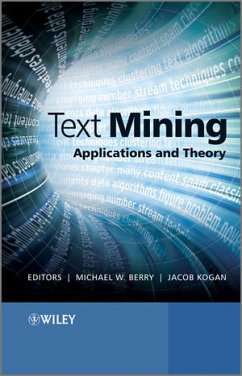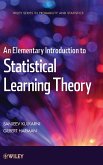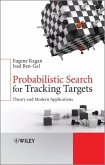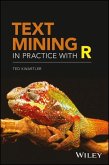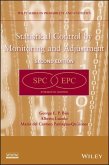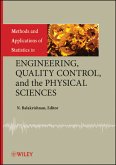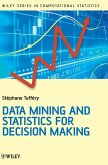Text Mining
Applications and Theory
Herausgeber: Berry, Michael W; Kogan, Jacob
Text Mining
Applications and Theory
Herausgeber: Berry, Michael W; Kogan, Jacob
- Gebundenes Buch
- Merkliste
- Auf die Merkliste
- Bewerten Bewerten
- Teilen
- Produkt teilen
- Produkterinnerung
- Produkterinnerung
Text Mining: Applications and Theory presents the state-of-the-art algorithms for text mining from both the academic and industrial perspectives. The contributors span several countries and scientific domains: universities, industrial corporations, and government laboratories, and demonstrate the use of techniques from machine learning, knowledge discovery, natural language processing and information retrieval to design computational models for automated text analysis and mining. This volume demonstrates how advancements in the fields of applied mathematics, computer science, machine learning,…mehr
Andere Kunden interessierten sich auch für
![An Elementary Introduction to Statistical Learning Theory An Elementary Introduction to Statistical Learning Theory]() Sanjeev KulkarniAn Elementary Introduction to Statistical Learning Theory137,99 €
Sanjeev KulkarniAn Elementary Introduction to Statistical Learning Theory137,99 €![Probabilistic Search for Tracking Targets Probabilistic Search for Tracking Targets]() Irad Ben-GalProbabilistic Search for Tracking Targets111,99 €
Irad Ben-GalProbabilistic Search for Tracking Targets111,99 €![Text Mining in Practice with R Text Mining in Practice with R]() Ted KwartlerText Mining in Practice with R92,99 €
Ted KwartlerText Mining in Practice with R92,99 €![Statistical Control by Monitoring and Adjustment Statistical Control by Monitoring and Adjustment]() George E P BoxStatistical Control by Monitoring and Adjustment157,99 €
George E P BoxStatistical Control by Monitoring and Adjustment157,99 €![Methods and Applications of Statistics in Engineering, Quality Control, and the Physical Sciences Methods and Applications of Statistics in Engineering, Quality Control, and the Physical Sciences]() Methods and Applications of Statistics in Engineering, Quality Control, and the Physical Sciences253,99 €
Methods and Applications of Statistics in Engineering, Quality Control, and the Physical Sciences253,99 €![Statistics for Imaging, Optics, and Photonics Statistics for Imaging, Optics, and Photonics]() Peter BajorskiStatistics for Imaging, Optics, and Photonics120,99 €
Peter BajorskiStatistics for Imaging, Optics, and Photonics120,99 €![Data Mining and Statistics for Decision Making Data Mining and Statistics for Decision Making]() Stéphane TufféryData Mining and Statistics for Decision Making119,99 €
Stéphane TufféryData Mining and Statistics for Decision Making119,99 €-
-
-
Text Mining: Applications and Theory presents the state-of-the-art algorithms for text mining from both the academic and industrial perspectives. The contributors span several countries and scientific domains: universities, industrial corporations, and government laboratories, and demonstrate the use of techniques from machine learning, knowledge discovery, natural language processing and information retrieval to design computational models for automated text analysis and mining. This volume demonstrates how advancements in the fields of applied mathematics, computer science, machine learning, and natural language processing can collectively capture, classify, and interpret words and their contexts. As suggested in the preface, text mining is needed when "words are not enough." This book: * Provides state-of-the-art algorithms and techniques for critical tasks in text mining applications, such as clustering, classification, anomaly and trend detection, and stream analysis. * Presents a survey of text visualization techniques and looks at the multilingual text classification problem. * Discusses the issue of cybercrime associated with chatrooms. * Features advances in visual analytics and machine learning along with illustrative examples. * Is accompanied by a supporting website featuring datasets. Applied mathematicians, statisticians, practitioners and students in computer science, bioinformatics and engineering will find this book extremely useful.
Hinweis: Dieser Artikel kann nur an eine deutsche Lieferadresse ausgeliefert werden.
Hinweis: Dieser Artikel kann nur an eine deutsche Lieferadresse ausgeliefert werden.
Produktdetails
- Produktdetails
- Verlag: John Wiley & Sons / Wiley
- Seitenzahl: 224
- Erscheinungstermin: 3. Mai 2010
- Englisch
- Abmessung: 239mm x 159mm x 17mm
- Gewicht: 488g
- ISBN-13: 9780470749821
- ISBN-10: 0470749822
- Artikelnr.: 28707756
- Herstellerkennzeichnung
- Libri GmbH
- Europaallee 1
- 36244 Bad Hersfeld
- gpsr@libri.de
- Verlag: John Wiley & Sons / Wiley
- Seitenzahl: 224
- Erscheinungstermin: 3. Mai 2010
- Englisch
- Abmessung: 239mm x 159mm x 17mm
- Gewicht: 488g
- ISBN-13: 9780470749821
- ISBN-10: 0470749822
- Artikelnr.: 28707756
- Herstellerkennzeichnung
- Libri GmbH
- Europaallee 1
- 36244 Bad Hersfeld
- gpsr@libri.de
Michael W. Berry, Professor and Associate Department Head, Department of Electrical Engineering and Computer Science, University of Tennessee. Michael is on the Editorial board of Computing in Science and Engineering and Statistical Analysis and Data Mining Journals. Jacob Kogan, Department of Mathematics and Statistics, University of Maryland Baltimore County, USA.
List of Contributors xi
Preface xiii
Part I Text Extraction, Classification, and Clustering 1
1 Automatic keyword extraction from individual documents 3
1.1 Introduction 3
1.1.1 Keyword extraction methods 4
1.2 Rapid automatic keyword extraction 5
1.2.1 Candidate keywords 6
1.2.2 Keyword scores 7
1.2.3 Adjoining keywords 8
1.2.4 Extracted keywords 8
1.3 Benchmark evaluation 9
1.3.1 Evaluating precision and recall 9
1.3.2 Evaluating efficiency 10
1.4 Stoplist generation 11
1.5 Evaluation on news articles 15
1.5.1 The MPQA Corpus 15
1.5.2 Extracting keywords from news articles 15
1.6 Summary 18
1.7 Acknowledgements 19
References 19
2 Algebraic techniques for multilingual document clustering 21
2.1 Introduction 21
2.2 Background 22
2.3 Experimental setup 23
2.4 Multilingual LSA 25
2.5 Tucker1 method 27
2.6 PARAFAC2 method 28
2.7 LSA with term alignments 29
2.8 Latent morpho-semantic analysis (LMSA) 32
2.9 LMSA with term alignments 33
2.10 Discussion of results and techniques 33
2.11 Acknowledgements 35
References 35
3 Content-based spam email classification using machine-learning algorithms
37
3.1 Introduction 37
3.2 Machine-learning algorithms 39
3.2.1 Naive Bayes 39
3.2.2 LogitBoost 40
3.2.3 Support vector machines 41
3.2.4 Augmented latent semantic indexing spaces 43
3.2.5 Radial basis function networks 44
3.3 Data preprocessing 45
3.3.1 Feature selection 45
3.3.2 Message representation 47
3.4 Evaluation of email classification 48
3.5 Experiments 49
3.5.1 Experiments with PU 1 49
3.5.2 Experiments with ZH 1 51
3.6 Characteristics of classifiers 53
3.7 Concluding remarks 54
3.8 Acknowledgements 55
References 55
4 Utilizing nonnegative matrix factorization for email classification
problems 57
4.1 Introduction 57
4.1.1 Related work 59
4.1.2 Synopsis 60
4.2 Background 60
4.2.1 Nonnegative matrix factorization 60
4.2.2 Algorithms for computing NMF 61
4.2.3 Datasets 63
4.2.4 Interpretation 64
4.3 NMF initialization based on feature ranking 65
4.3.1 Feature subset selection 66
4.3.2 FS initialization 66
4.4 NMF-based classification methods 70
4.4.1 Classification using basis features 70
4.4.2 Generalizing LSI based on NMF 72
4.5 Conclusions 78
4.6 Acknowledgements 79
References 79
5 Constrained clustering with k-means type algorithms 81
5.1 Introduction 81
5.2 Notations and classical k-means 82
5.3 Constrained k-means with Bregman divergences 84
5.3.1 Quadratic k-means with cannot-link constraints 84
5.3.2 Elimination of must-link constraints 87
5.3.3 Clustering with Bregman divergences 89
5.4 Constrained smoka type clustering 92
5.5 Constrained spherical k-means 95
5.5.1 Spherical k-means with cannot-link constraints only 96
5.5.2 Spherical k-means with cannot-link and must-link constraints 98
5.6 Numerical experiments 99
5.6.1 Quadratic k-means 100
5.6.2 Spherical k-means 100
5.7 Conclusion 101
References 102
Part II Anomaly and Trend Detection 105
6 Survey of text visualization techniques 107
6.1 Visualization in text analysis 107
6.2 Tag clouds 108
6.3 Authorship and change tracking 110
6.4 Data exploration and the search for novel patterns 111
6.5 Sentiment tracking 111
6.6 Visual analytics and FutureLens 113
6.7 Scenario discovery 114
6.7.1 Scenarios 115
6.7.2 Evaluating solutions 115
6.8 Earlier prototype 116
6.9 Features of FutureLens 117
6.10 Scenario discovery example: bioterrorism 119
6.11 Scenario discovery example: drug trafficking 121
6.12 Future work 123
References 126
7 Adaptive threshold setting for novelty mining 129
7.1 Introduction 129
7.2 Adaptive threshold setting in novelty mining 131
7.2.1 Background 131
7.2.2 Motivation 132
7.2.3 Gaussian-based adaptive threshold setting 132
7.2.4 Implementation issues 137
7.3 Experimental study 138
7.3.1 Datasets 138
7.3.2 Working example 139
7.3.3 Experiments and results 142
7.4 Conclusion 146
References 147
8 Text mining and cybercrime 149
8.1 Introduction 149
8.2 Current research in Internet predation and cyberbullying 151
8.2.1 Capturing IM and IRC chat 151
8.2.2 Current collections for use in analysis 152
8.2.3 Analysis of IM and IRC chat 153
8.2.4 Internet predation detection 153
8.2.5 Cyberbullying detection 158
8.2.6 Legal issues 159
8.3 Commercial software for monitoring chat 159
8.4 Conclusions and future directions 161
8.5 Acknowledgements 162
References 162
Part III Text Streams 165
9 Events and trends in text streams 167
9.1 Introduction 167
9.2 Text streams 169
9.3 Feature extraction and data reduction 170
9.4 Event detection 171
9.5 Trend detection 174
9.6 Event and trend descriptions 176
9.7 Discussion 180
9.8 Summary 181
9.9 Acknowledgements 181
References 181
10 Embedding semantics in LDA topic models 183
10.1 Introduction 183
10.2 Background 184
10.2.1 Vector space modeling 184
10.2.2 Latent semantic analysis 185
10.2.3 Probabilistic latent semantic analysis 185
10.3 Latent Dirichlet allocation 186
10.3.1 Graphical model and generative process 187
10.3.2 Posterior inference 187
10.3.3 Online latent Dirichlet allocation (OLDA) 189
10.3.4 Illustrative example 191
10.4 Embedding external semantics from Wikipedia 193
10.4.1 Related Wikipedia articles 194
10.4.2 Wikipedia-influenced topic model 194
10.5 Data-driven semantic embedding 194
10.5.1 Generative process with data-driven semantic embedding 195
10.5.2 OLDA algorithm with data-driven semantic embedding 196
10.5.3 Experimental design 197
10.5.4 Experimental results 199
10.6 Related work 202
10.7 Conclusion and future work 202
References 203
Index 205
Preface xiii
Part I Text Extraction, Classification, and Clustering 1
1 Automatic keyword extraction from individual documents 3
1.1 Introduction 3
1.1.1 Keyword extraction methods 4
1.2 Rapid automatic keyword extraction 5
1.2.1 Candidate keywords 6
1.2.2 Keyword scores 7
1.2.3 Adjoining keywords 8
1.2.4 Extracted keywords 8
1.3 Benchmark evaluation 9
1.3.1 Evaluating precision and recall 9
1.3.2 Evaluating efficiency 10
1.4 Stoplist generation 11
1.5 Evaluation on news articles 15
1.5.1 The MPQA Corpus 15
1.5.2 Extracting keywords from news articles 15
1.6 Summary 18
1.7 Acknowledgements 19
References 19
2 Algebraic techniques for multilingual document clustering 21
2.1 Introduction 21
2.2 Background 22
2.3 Experimental setup 23
2.4 Multilingual LSA 25
2.5 Tucker1 method 27
2.6 PARAFAC2 method 28
2.7 LSA with term alignments 29
2.8 Latent morpho-semantic analysis (LMSA) 32
2.9 LMSA with term alignments 33
2.10 Discussion of results and techniques 33
2.11 Acknowledgements 35
References 35
3 Content-based spam email classification using machine-learning algorithms
37
3.1 Introduction 37
3.2 Machine-learning algorithms 39
3.2.1 Naive Bayes 39
3.2.2 LogitBoost 40
3.2.3 Support vector machines 41
3.2.4 Augmented latent semantic indexing spaces 43
3.2.5 Radial basis function networks 44
3.3 Data preprocessing 45
3.3.1 Feature selection 45
3.3.2 Message representation 47
3.4 Evaluation of email classification 48
3.5 Experiments 49
3.5.1 Experiments with PU 1 49
3.5.2 Experiments with ZH 1 51
3.6 Characteristics of classifiers 53
3.7 Concluding remarks 54
3.8 Acknowledgements 55
References 55
4 Utilizing nonnegative matrix factorization for email classification
problems 57
4.1 Introduction 57
4.1.1 Related work 59
4.1.2 Synopsis 60
4.2 Background 60
4.2.1 Nonnegative matrix factorization 60
4.2.2 Algorithms for computing NMF 61
4.2.3 Datasets 63
4.2.4 Interpretation 64
4.3 NMF initialization based on feature ranking 65
4.3.1 Feature subset selection 66
4.3.2 FS initialization 66
4.4 NMF-based classification methods 70
4.4.1 Classification using basis features 70
4.4.2 Generalizing LSI based on NMF 72
4.5 Conclusions 78
4.6 Acknowledgements 79
References 79
5 Constrained clustering with k-means type algorithms 81
5.1 Introduction 81
5.2 Notations and classical k-means 82
5.3 Constrained k-means with Bregman divergences 84
5.3.1 Quadratic k-means with cannot-link constraints 84
5.3.2 Elimination of must-link constraints 87
5.3.3 Clustering with Bregman divergences 89
5.4 Constrained smoka type clustering 92
5.5 Constrained spherical k-means 95
5.5.1 Spherical k-means with cannot-link constraints only 96
5.5.2 Spherical k-means with cannot-link and must-link constraints 98
5.6 Numerical experiments 99
5.6.1 Quadratic k-means 100
5.6.2 Spherical k-means 100
5.7 Conclusion 101
References 102
Part II Anomaly and Trend Detection 105
6 Survey of text visualization techniques 107
6.1 Visualization in text analysis 107
6.2 Tag clouds 108
6.3 Authorship and change tracking 110
6.4 Data exploration and the search for novel patterns 111
6.5 Sentiment tracking 111
6.6 Visual analytics and FutureLens 113
6.7 Scenario discovery 114
6.7.1 Scenarios 115
6.7.2 Evaluating solutions 115
6.8 Earlier prototype 116
6.9 Features of FutureLens 117
6.10 Scenario discovery example: bioterrorism 119
6.11 Scenario discovery example: drug trafficking 121
6.12 Future work 123
References 126
7 Adaptive threshold setting for novelty mining 129
7.1 Introduction 129
7.2 Adaptive threshold setting in novelty mining 131
7.2.1 Background 131
7.2.2 Motivation 132
7.2.3 Gaussian-based adaptive threshold setting 132
7.2.4 Implementation issues 137
7.3 Experimental study 138
7.3.1 Datasets 138
7.3.2 Working example 139
7.3.3 Experiments and results 142
7.4 Conclusion 146
References 147
8 Text mining and cybercrime 149
8.1 Introduction 149
8.2 Current research in Internet predation and cyberbullying 151
8.2.1 Capturing IM and IRC chat 151
8.2.2 Current collections for use in analysis 152
8.2.3 Analysis of IM and IRC chat 153
8.2.4 Internet predation detection 153
8.2.5 Cyberbullying detection 158
8.2.6 Legal issues 159
8.3 Commercial software for monitoring chat 159
8.4 Conclusions and future directions 161
8.5 Acknowledgements 162
References 162
Part III Text Streams 165
9 Events and trends in text streams 167
9.1 Introduction 167
9.2 Text streams 169
9.3 Feature extraction and data reduction 170
9.4 Event detection 171
9.5 Trend detection 174
9.6 Event and trend descriptions 176
9.7 Discussion 180
9.8 Summary 181
9.9 Acknowledgements 181
References 181
10 Embedding semantics in LDA topic models 183
10.1 Introduction 183
10.2 Background 184
10.2.1 Vector space modeling 184
10.2.2 Latent semantic analysis 185
10.2.3 Probabilistic latent semantic analysis 185
10.3 Latent Dirichlet allocation 186
10.3.1 Graphical model and generative process 187
10.3.2 Posterior inference 187
10.3.3 Online latent Dirichlet allocation (OLDA) 189
10.3.4 Illustrative example 191
10.4 Embedding external semantics from Wikipedia 193
10.4.1 Related Wikipedia articles 194
10.4.2 Wikipedia-influenced topic model 194
10.5 Data-driven semantic embedding 194
10.5.1 Generative process with data-driven semantic embedding 195
10.5.2 OLDA algorithm with data-driven semantic embedding 196
10.5.3 Experimental design 197
10.5.4 Experimental results 199
10.6 Related work 202
10.7 Conclusion and future work 202
References 203
Index 205
List of Contributors xi
Preface xiii
Part I Text Extraction, Classification, and Clustering 1
1 Automatic keyword extraction from individual documents 3
1.1 Introduction 3
1.1.1 Keyword extraction methods 4
1.2 Rapid automatic keyword extraction 5
1.2.1 Candidate keywords 6
1.2.2 Keyword scores 7
1.2.3 Adjoining keywords 8
1.2.4 Extracted keywords 8
1.3 Benchmark evaluation 9
1.3.1 Evaluating precision and recall 9
1.3.2 Evaluating efficiency 10
1.4 Stoplist generation 11
1.5 Evaluation on news articles 15
1.5.1 The MPQA Corpus 15
1.5.2 Extracting keywords from news articles 15
1.6 Summary 18
1.7 Acknowledgements 19
References 19
2 Algebraic techniques for multilingual document clustering 21
2.1 Introduction 21
2.2 Background 22
2.3 Experimental setup 23
2.4 Multilingual LSA 25
2.5 Tucker1 method 27
2.6 PARAFAC2 method 28
2.7 LSA with term alignments 29
2.8 Latent morpho-semantic analysis (LMSA) 32
2.9 LMSA with term alignments 33
2.10 Discussion of results and techniques 33
2.11 Acknowledgements 35
References 35
3 Content-based spam email classification using machine-learning algorithms
37
3.1 Introduction 37
3.2 Machine-learning algorithms 39
3.2.1 Naive Bayes 39
3.2.2 LogitBoost 40
3.2.3 Support vector machines 41
3.2.4 Augmented latent semantic indexing spaces 43
3.2.5 Radial basis function networks 44
3.3 Data preprocessing 45
3.3.1 Feature selection 45
3.3.2 Message representation 47
3.4 Evaluation of email classification 48
3.5 Experiments 49
3.5.1 Experiments with PU 1 49
3.5.2 Experiments with ZH 1 51
3.6 Characteristics of classifiers 53
3.7 Concluding remarks 54
3.8 Acknowledgements 55
References 55
4 Utilizing nonnegative matrix factorization for email classification
problems 57
4.1 Introduction 57
4.1.1 Related work 59
4.1.2 Synopsis 60
4.2 Background 60
4.2.1 Nonnegative matrix factorization 60
4.2.2 Algorithms for computing NMF 61
4.2.3 Datasets 63
4.2.4 Interpretation 64
4.3 NMF initialization based on feature ranking 65
4.3.1 Feature subset selection 66
4.3.2 FS initialization 66
4.4 NMF-based classification methods 70
4.4.1 Classification using basis features 70
4.4.2 Generalizing LSI based on NMF 72
4.5 Conclusions 78
4.6 Acknowledgements 79
References 79
5 Constrained clustering with k-means type algorithms 81
5.1 Introduction 81
5.2 Notations and classical k-means 82
5.3 Constrained k-means with Bregman divergences 84
5.3.1 Quadratic k-means with cannot-link constraints 84
5.3.2 Elimination of must-link constraints 87
5.3.3 Clustering with Bregman divergences 89
5.4 Constrained smoka type clustering 92
5.5 Constrained spherical k-means 95
5.5.1 Spherical k-means with cannot-link constraints only 96
5.5.2 Spherical k-means with cannot-link and must-link constraints 98
5.6 Numerical experiments 99
5.6.1 Quadratic k-means 100
5.6.2 Spherical k-means 100
5.7 Conclusion 101
References 102
Part II Anomaly and Trend Detection 105
6 Survey of text visualization techniques 107
6.1 Visualization in text analysis 107
6.2 Tag clouds 108
6.3 Authorship and change tracking 110
6.4 Data exploration and the search for novel patterns 111
6.5 Sentiment tracking 111
6.6 Visual analytics and FutureLens 113
6.7 Scenario discovery 114
6.7.1 Scenarios 115
6.7.2 Evaluating solutions 115
6.8 Earlier prototype 116
6.9 Features of FutureLens 117
6.10 Scenario discovery example: bioterrorism 119
6.11 Scenario discovery example: drug trafficking 121
6.12 Future work 123
References 126
7 Adaptive threshold setting for novelty mining 129
7.1 Introduction 129
7.2 Adaptive threshold setting in novelty mining 131
7.2.1 Background 131
7.2.2 Motivation 132
7.2.3 Gaussian-based adaptive threshold setting 132
7.2.4 Implementation issues 137
7.3 Experimental study 138
7.3.1 Datasets 138
7.3.2 Working example 139
7.3.3 Experiments and results 142
7.4 Conclusion 146
References 147
8 Text mining and cybercrime 149
8.1 Introduction 149
8.2 Current research in Internet predation and cyberbullying 151
8.2.1 Capturing IM and IRC chat 151
8.2.2 Current collections for use in analysis 152
8.2.3 Analysis of IM and IRC chat 153
8.2.4 Internet predation detection 153
8.2.5 Cyberbullying detection 158
8.2.6 Legal issues 159
8.3 Commercial software for monitoring chat 159
8.4 Conclusions and future directions 161
8.5 Acknowledgements 162
References 162
Part III Text Streams 165
9 Events and trends in text streams 167
9.1 Introduction 167
9.2 Text streams 169
9.3 Feature extraction and data reduction 170
9.4 Event detection 171
9.5 Trend detection 174
9.6 Event and trend descriptions 176
9.7 Discussion 180
9.8 Summary 181
9.9 Acknowledgements 181
References 181
10 Embedding semantics in LDA topic models 183
10.1 Introduction 183
10.2 Background 184
10.2.1 Vector space modeling 184
10.2.2 Latent semantic analysis 185
10.2.3 Probabilistic latent semantic analysis 185
10.3 Latent Dirichlet allocation 186
10.3.1 Graphical model and generative process 187
10.3.2 Posterior inference 187
10.3.3 Online latent Dirichlet allocation (OLDA) 189
10.3.4 Illustrative example 191
10.4 Embedding external semantics from Wikipedia 193
10.4.1 Related Wikipedia articles 194
10.4.2 Wikipedia-influenced topic model 194
10.5 Data-driven semantic embedding 194
10.5.1 Generative process with data-driven semantic embedding 195
10.5.2 OLDA algorithm with data-driven semantic embedding 196
10.5.3 Experimental design 197
10.5.4 Experimental results 199
10.6 Related work 202
10.7 Conclusion and future work 202
References 203
Index 205
Preface xiii
Part I Text Extraction, Classification, and Clustering 1
1 Automatic keyword extraction from individual documents 3
1.1 Introduction 3
1.1.1 Keyword extraction methods 4
1.2 Rapid automatic keyword extraction 5
1.2.1 Candidate keywords 6
1.2.2 Keyword scores 7
1.2.3 Adjoining keywords 8
1.2.4 Extracted keywords 8
1.3 Benchmark evaluation 9
1.3.1 Evaluating precision and recall 9
1.3.2 Evaluating efficiency 10
1.4 Stoplist generation 11
1.5 Evaluation on news articles 15
1.5.1 The MPQA Corpus 15
1.5.2 Extracting keywords from news articles 15
1.6 Summary 18
1.7 Acknowledgements 19
References 19
2 Algebraic techniques for multilingual document clustering 21
2.1 Introduction 21
2.2 Background 22
2.3 Experimental setup 23
2.4 Multilingual LSA 25
2.5 Tucker1 method 27
2.6 PARAFAC2 method 28
2.7 LSA with term alignments 29
2.8 Latent morpho-semantic analysis (LMSA) 32
2.9 LMSA with term alignments 33
2.10 Discussion of results and techniques 33
2.11 Acknowledgements 35
References 35
3 Content-based spam email classification using machine-learning algorithms
37
3.1 Introduction 37
3.2 Machine-learning algorithms 39
3.2.1 Naive Bayes 39
3.2.2 LogitBoost 40
3.2.3 Support vector machines 41
3.2.4 Augmented latent semantic indexing spaces 43
3.2.5 Radial basis function networks 44
3.3 Data preprocessing 45
3.3.1 Feature selection 45
3.3.2 Message representation 47
3.4 Evaluation of email classification 48
3.5 Experiments 49
3.5.1 Experiments with PU 1 49
3.5.2 Experiments with ZH 1 51
3.6 Characteristics of classifiers 53
3.7 Concluding remarks 54
3.8 Acknowledgements 55
References 55
4 Utilizing nonnegative matrix factorization for email classification
problems 57
4.1 Introduction 57
4.1.1 Related work 59
4.1.2 Synopsis 60
4.2 Background 60
4.2.1 Nonnegative matrix factorization 60
4.2.2 Algorithms for computing NMF 61
4.2.3 Datasets 63
4.2.4 Interpretation 64
4.3 NMF initialization based on feature ranking 65
4.3.1 Feature subset selection 66
4.3.2 FS initialization 66
4.4 NMF-based classification methods 70
4.4.1 Classification using basis features 70
4.4.2 Generalizing LSI based on NMF 72
4.5 Conclusions 78
4.6 Acknowledgements 79
References 79
5 Constrained clustering with k-means type algorithms 81
5.1 Introduction 81
5.2 Notations and classical k-means 82
5.3 Constrained k-means with Bregman divergences 84
5.3.1 Quadratic k-means with cannot-link constraints 84
5.3.2 Elimination of must-link constraints 87
5.3.3 Clustering with Bregman divergences 89
5.4 Constrained smoka type clustering 92
5.5 Constrained spherical k-means 95
5.5.1 Spherical k-means with cannot-link constraints only 96
5.5.2 Spherical k-means with cannot-link and must-link constraints 98
5.6 Numerical experiments 99
5.6.1 Quadratic k-means 100
5.6.2 Spherical k-means 100
5.7 Conclusion 101
References 102
Part II Anomaly and Trend Detection 105
6 Survey of text visualization techniques 107
6.1 Visualization in text analysis 107
6.2 Tag clouds 108
6.3 Authorship and change tracking 110
6.4 Data exploration and the search for novel patterns 111
6.5 Sentiment tracking 111
6.6 Visual analytics and FutureLens 113
6.7 Scenario discovery 114
6.7.1 Scenarios 115
6.7.2 Evaluating solutions 115
6.8 Earlier prototype 116
6.9 Features of FutureLens 117
6.10 Scenario discovery example: bioterrorism 119
6.11 Scenario discovery example: drug trafficking 121
6.12 Future work 123
References 126
7 Adaptive threshold setting for novelty mining 129
7.1 Introduction 129
7.2 Adaptive threshold setting in novelty mining 131
7.2.1 Background 131
7.2.2 Motivation 132
7.2.3 Gaussian-based adaptive threshold setting 132
7.2.4 Implementation issues 137
7.3 Experimental study 138
7.3.1 Datasets 138
7.3.2 Working example 139
7.3.3 Experiments and results 142
7.4 Conclusion 146
References 147
8 Text mining and cybercrime 149
8.1 Introduction 149
8.2 Current research in Internet predation and cyberbullying 151
8.2.1 Capturing IM and IRC chat 151
8.2.2 Current collections for use in analysis 152
8.2.3 Analysis of IM and IRC chat 153
8.2.4 Internet predation detection 153
8.2.5 Cyberbullying detection 158
8.2.6 Legal issues 159
8.3 Commercial software for monitoring chat 159
8.4 Conclusions and future directions 161
8.5 Acknowledgements 162
References 162
Part III Text Streams 165
9 Events and trends in text streams 167
9.1 Introduction 167
9.2 Text streams 169
9.3 Feature extraction and data reduction 170
9.4 Event detection 171
9.5 Trend detection 174
9.6 Event and trend descriptions 176
9.7 Discussion 180
9.8 Summary 181
9.9 Acknowledgements 181
References 181
10 Embedding semantics in LDA topic models 183
10.1 Introduction 183
10.2 Background 184
10.2.1 Vector space modeling 184
10.2.2 Latent semantic analysis 185
10.2.3 Probabilistic latent semantic analysis 185
10.3 Latent Dirichlet allocation 186
10.3.1 Graphical model and generative process 187
10.3.2 Posterior inference 187
10.3.3 Online latent Dirichlet allocation (OLDA) 189
10.3.4 Illustrative example 191
10.4 Embedding external semantics from Wikipedia 193
10.4.1 Related Wikipedia articles 194
10.4.2 Wikipedia-influenced topic model 194
10.5 Data-driven semantic embedding 194
10.5.1 Generative process with data-driven semantic embedding 195
10.5.2 OLDA algorithm with data-driven semantic embedding 196
10.5.3 Experimental design 197
10.5.4 Experimental results 199
10.6 Related work 202
10.7 Conclusion and future work 202
References 203
Index 205

